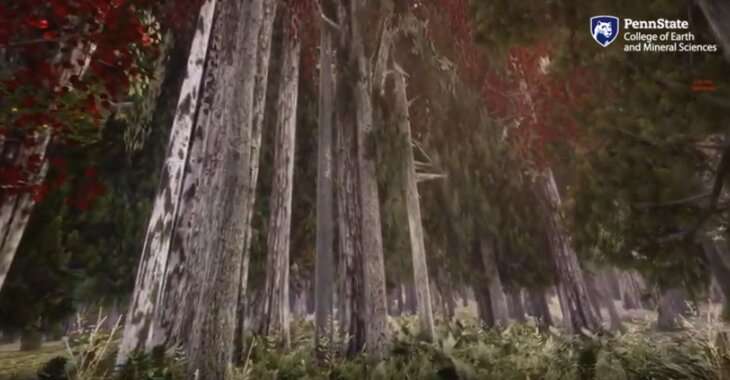Virtual reality forests could help understanding of climate change

The effects of climate change are sometimes difficult to grasp, but now a virtual reality forest, created by geographers, can let people walk through a simulated forest of today and see what various futures may hold for the trees.
"The main problem that needs to be addressed is that climate change is abstract," said Alexander Klippel, professor of geography, Penn State. "Its meaning only unfolds in 10, 15 or 100 years. It is very hard for people to understand and plan and make decisions."
The researchers combined information on forest composition with information on forest ecology to create a forest similar to those found in Wisconsin.
"As part of an NSF-funded CNH program grant with Erica Smithwick (E. Willard and Ruby S. Miller Professor of Geography at Penn State) we are working with the Menominee Indian Tribe of Wisconsin," said Klippel, who also is director of Penn State's Center for Immersive Experience. "Inspired by the Menominee's deeper connection to the environment we believe that experiencing the future is essential for all environmental decision making."
The virtual-reality experience takes the extensive climate change models, sophisticated vegetation models and ecological models and creates a 2050 forest that people can experience by walking through it, investigating the tree types and understory, and seeing the changes.
The first step, of course, was to create a forest of today. Using data on a typical Wisconsin forest, the researchers could have used strict or deterministic rules and placed trees in the forest. However, they chose to use a procedural method that would populate the forest using a set of ecological rules, creating a more organic, natural feel.
"Orientation and small details of the trees are also randomized in the approach so that the trees don't look exactly the same," said Jiawei Huang, graduate student in geography, Penn State.
The researchers report today (Nov. 11) in the International Journal of Geographical Information Science that, "Procedural rules allowed us to efficiently and reproducibly translate the parameters into a simulated forest." They used analytical modeling to convert the data for procedural modeling. They also worked with ecological experts to provide feedback and evaluate the results.
To capture the ecology of the forest, the researchers used LANDIS II, a well-established, powerful model.
"Our ecologist colleagues, coauthors on this paper—Melissa S. Lucash, research assistant professor of geography, University of Oregon, and Robert M. Scheller, professor of geography, North Carolina State University—ensured the expertise that is necessary to make the predictions accurate," said Klippel.
The researchers note that the model is powerful enough to deal with events such as windstorms, fire and flooding, and, of course, climate change.
A virtual walk through this Wisconsin forest shows tall trees and understory. Strollers, using VR headsets and controllers, can reveal the types of trees in the forest, change elevations from forest floor to birds-eye view and in-between, and more closely examine the forest composition.
The researchers chose two future scenarios, a base scenario and a hot and dry scenario. Using VR, visitors to the forest can see the changes in tree types and abundance and compare the base scenario to the hot and dry scenario.
"Our approach to create visceral experiences of forests under climate change can facilitate communication among experts, policymakers and the general public," the researchers report.
The researchers aim is to create a medium to communicate things in the future or the past that allows for a more holistic and visceral access so that non-experts can see the changes brought on by climate change.
More information: Jiawei Huang et al, Walking through the forests of the future: using data-driven virtual reality to visualize forests under climate change, International Journal of Geographical Information Science (2020). DOI: 10.1080/13658816.2020.1830997
Provided by Pennsylvania State University





















